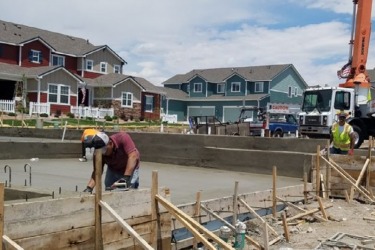The terms “raft footing” and “mat foundation” describe the same type of building foundation. Both envision a horizontal plane, or slab, of reinforced concrete upon which you construct a building.
FEATURES OF A MAT FOUNDATION OR RAFT FOOTING
All foundation footings distribute the weight of the building to the supporting soil below. In certain conditions where the soil offers less solid support than desired, regular grade beam or pier footings may not suffice to underpin the foundation. Imagine a wooden plank that you want to ride across a lazy river. If you were to straddle one of its thin edges, your weight would sink the board. But if you sit on one of its broad sides, you could float across the water without sinking. The wide side of the plank distributes your weight on the surface of the water to keep you afloat. The longer and broader the plank, the less you weigh to the water directly below you. Foundation footings act on the same principle. You can also think of the slab foundation as a large mat upon the ground.
Mat foundations or raft footings comprise a thick slab of reinforced concrete on the soil that supports the entire building. They spread the weight of the building over its expanse when weak soil is incapable of taking too much stress. Compressive soil tends to disallow economical piles or grade beam footings which transfer too much load to a too small area of soil. Rather, to construct the building on piles or beam footings, you may have to excavate to bedrock if the upper layers of dirt are too loose. Rafts or mats provide a common footing to all of the columns and/or load-bearing walls in the building, evenly transferring the building’s load to the ground. This permits shallower excavation.
Typically, ground that can compress or is prone to subsidence (the sinking of the ground beyond mere settlement) would be suitable for raft footings. You don’t always get the perfect substrate for your building project, but you can choose a mat or raft foundation that compensates for it.
BENEFITS OF RAFT FOOTINGS/MAT FOUNDATIONS
Besides offering greater stabilization on compressive or loose soils, raft footings or mat foundations provide other benefits for certain building applications.
- Where the strata below the site has been mined, leaving the grade susceptible to movement, you can construct with confidence on mats or rafts.
- If the project calls for so many columns that their combined footprints would cover more than 50 percent of the ground area, it’s more economical to simply pour a common footer for all. Thicker lines of concrete on the underside of the slab — inverted beam footings cast as a piece with the mat — can shore up the line of columns above.
- Raft footers help with differential settlement by maintaining foundation integrity evenly under all the vertical supports. The rebar reinforcement, which grants the mat superior tensile strength, helps prevent settlement cracks when one area of the soil settles faster than others.
- Mat foundations handle large loads well, making them perfect for commercial concrete structures. Under single residences, they may present the best foundation option where the water conditions of the substrate cause concern. By placing the mat foundation over a well-drained, sturdily compacted hardcore layer topped by sand, you can minimize the risk of damage from heaving.
- Because you can pour the basement floor screed over the moisture barrier on top of the raft, this system requires less preparation and therefore conserves costs.
Raft footings and mat foundations are two ways to say the same thing. Colorado possesses many types of soil conditions which can present special challenges to the foundation design. The experts at Barton Supply happily work with architects, engineers and other construction professionals to plan the best foundation and building solutions for the best prices along the Colorado Front Range. If you would like to discuss raft/mat foundations, concrete reinforcement or anything related to your Colorado construction project, please call us today!
